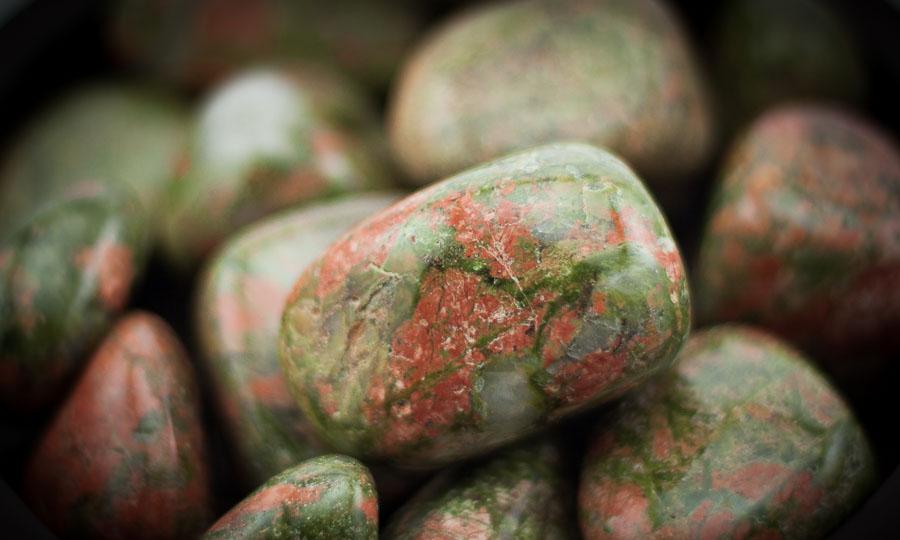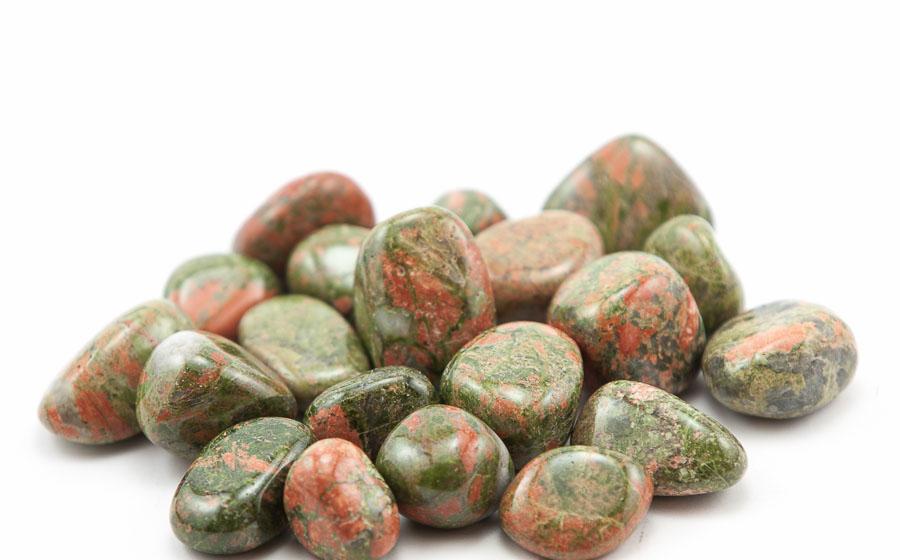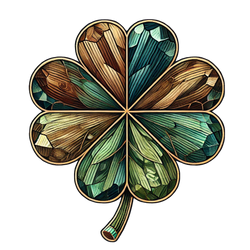You will not be allowed to compare more than 4 products at a time
View compareUnakite Tumbled 1 lb
Unakite Tumbled 1 lb
Estimate delivery times:5-8 days.
Flat Rate Shipping and FREE Shipping on orders more than $100.
About This Product
Unakite – The Stone of Emotional Renewal and Grounded Growth
Introduction
Unakite’s earthy beauty is immediately recognizable by its distinctive mottled tapestry of mossy green and warm pink. Swirls of pistachio-hued epidote wind through patches of salmon-colored feldspar, as if forest and sunset were entwined in stone. This unique color blend gives Unakite an organic, grounding presence – an earth-toned palette that often polishes to a gentle gloss. Smooth tumbled pieces reveal a marbled landscape of green and pink, each one unique, while rough fragments display the same harmonious pattern in a more rugged form. Holding a piece of Unakite, one can almost sense the quiet strength of ancient granite reborn, its surface a grounding pattern that is both soothing and intriguingly complex.
Historical and Cultural Background
Unakite’s story begins in the mountains of Appalachia. Geologists first discovered the stone in 1874 amid North Carolina’s Unaka Mountains (for which it is named), on the border of Tennessee. This American gemstone quickly became part of the local legacy – so much so that it was once proposed as the state stone of Virginia (though ultimately fossil coral was chosen instead). Large polished slabs of Unakite even adorn the halls of the Smithsonian National Museum of Natural History, where its pink-green mosaic graces floor tiles and staircase trimmings as a decorative stone.
Beyond its American origins, Unakite’s appeal has traveled worldwide. In the decades since its discovery, it gained recognition among gem and mineral enthusiasts across Europe, Africa, and Asia. In fact, modern lapidaries and crystal collectors from China to South Africa and Brazil have embraced Unakite, drawn to its hardy beauty and healing lore. Today, this American-born stone carries a global reputation – cherished not only as an ornamental rock but also as a symbol of healing in various cultural and spiritual communities. What began as a regional curiosity in the Unaka Range has become a mineral with an international following, bridging American geological heritage with worldwide metaphysical popularity.
Metaphysical Symbolism
In crystal healing circles, Unakite is often hailed as a gentle nurturer of the heart. It is closely associated with the Heart Chakra, believed to radiate energies of emotional healing, compassion, and self-love. Practitioners say Unakite’s green and pink union represents the balance of nurturing growth and compassionate love – green for steady, gentle grounding and pink for kindness and caring. This stone’s grounding energy is thought to embrace the heart, fostering feelings of love, empathy, and renewed self-worth.
Unakite is furthermore revered as a stone of emotional release and recovery. Healers often recommend it for those overcoming heartbreak, trauma, or grief, as its energy is said to slowly dissolve emotional blockages and release the pain of the past. In fact, Unakite is known for helping one let go of old wounds “with balance and patient persistence,” gently untangling attachments to past hurt. Many find comfort in its presence during times of sorrow – it is believed to aid in overcoming bouts of grief and loss, lifting the spirit in gradual, healing waves. Through this steady healing vibration, Unakite promotes emotional balance and harmony, encouraging us to be kinder to ourselves and others. It invites a state of inner peace by harmonizing emotions, encouraging forgiveness, and inspiring trust in the slow but sure process of healing. In essence, Unakite symbolizes recovered hope: the compassion to heal one’s heart, the patience to nurture personal growth, and the grounded strength to move forward after adversity.
Decorative and Luxury Appeal
Unakite’s unique appearance and polish make it a favorite not just of healers but also of designers and collectors. In the realm of jewelry, it is often fashioned into smooth cabochons and beads that showcase its rose-and-olive coloration. Artisans love how each piece’s pattern is one-of-a-kind – a pair of Unakite earrings or a strand of beads carries a natural bohemian elegance, with mottled pink and green orbs that can complement both earthy and upscale styles. Set in silver or gold, Unakite cabochons become eye-catching pendants and rings, their muted tones pairing well with both casual linen and formal wear. Jewelry designers and customers alike appreciate that this stone is relatively hard and takes a good polish, so it withstands carving and daily wear while shining with a warm, inviting luster.
Beyond jewelry, Unakite finds its place in many luxury décor and collectible forms. Its granitic, coarse-grained structure is excellent for lapidary art: craftsmen carve Unakite into ornamental spheres, eggs, and figurines, or cut it into tiles and inlays for tabletops and mosaic work. Tumbled Unakite stones – often sold as palm stones or worry stones – are silky smooth and fit perfectly in the hand, used for stress relief or meditation aids. Collectors often display bowls of polished Unakite pebbles or large freeform pieces on shelves, enjoying the natural aesthetic it brings. In home décor, the stone’s mix of colors adds an earthy charm; designers have turned Unakite into unique coffee table tops, bookends, or vase accents. In metaphysical and spiritual settings, one might find Unakite crystal grids or clusters adorning altars and meditation spaces, where its nurturing vibes enhance the ambiance. Even as a simple raw chunk, Unakite serves as a striking natural decor piece – a conversation starter with its unmissable pink-and-green patches. From high-end gemstone collections to cozy healing altars, Unakite effortlessly bridges the gap between rustic earthiness and refined beauty. Its presence carries a down-to-earth luxury, making it equally suited for a collector’s cabinet, a designer’s palette, or a healer’s toolkit.
Scientific Properties of Unakite
-
Chemical Composition: Not a single mineral but a composite rock – primarily pink orthoclase feldspar, green epidote, and clear to milky quartz. (In chemical terms, it contains potassium aluminum silicate, calcium aluminum iron silicate hydroxide, and silicon dioxide.) These three ingredients form Unakite’s signature colors: the feldspar gives the peachy pink, the epidote provides the mossy green, and quartz fills in with colorless or whitish translucent areas.
-
Crystal System: As Unakite is an aggregate, each component has its own system – the feldspar (a form of K-feldspar) crystallizes in the triclinic system, while epidote crystallizes in the monoclinic system. (Quartz is trigonal within the hexagonal family.) In Unakite, however, crystals are generally microscopic; the stone usually appears in massive form rather than distinct crystal shapes.
-
Mohs Hardness: ~6 to 7 on the Mohs scale. This moderate hardness means Unakite is fairly durable: it cannot be scratched by a fingernail and often not even by common steel, but it can be scratched by anything harder (like pure quartz). Its hardness, contributed by quartz and feldspar, allows it to take a good polish for jewelry and ornaments.
-
Luster: Typically vitreous to greasy when polished. Unakite’s quartz and feldspar content give freshly cut or tumbled surfaces a glassy sheen. In its raw, unpolished state, the luster is more dull or earthy, but once smoothed, the stone often gleams with a soft, oily shine that enhances its mottled colors.
-
Transparency: Opaque. Unakite does not transmit light due to its polycrystalline nature and mix of minerals. Even the quartz within it is clouded by inclusions. At most, thin edges of a chip might appear slightly translucent, but overall the stone is valued for its solid, opaque presentation.
-
Cleavage & Fracture: As a composite, Unakite does not exhibit a singular cleavage, but its major constituents (feldspar and epidote) both have perfect cleavage in certain directions. In practice, Unakite pieces tend to break unevenly, following the boundaries of crystals – yielding a fracture that is typically conchoidal to uneven. When struck or broken, it may split with curved, shell-like surfaces (thanks to quartz’s conchoidal fracture) or irregular rough faces. This means Unakite can be shaped by cutting, but care is needed to avoid splits along mineral planes.
-
Habit: Massive, coarse-grained granitic habit. Unakite is found as large solid masses or boulders rather than well-formed crystal structures. It essentially looks like a piece of granite with visible pink and green mineral grains. The texture is granular, with epidote and feldspar crystal grains interlocking. Fine-grained varieties exist, but most Unakite shows a coarse, blocky structure when examined closely.
-
Primary Sources: United States (especially the Unaka Range of North Carolina/Tennessee where it was first identified), and various global localities. Notable sources include parts of the Blue Ridge Mountains in Virginia (where river-worn pebbles of Unakite are common) and an outcrop in New Jersey historically called “Pompton granite.” Outside the US, significant deposits have been mined in South Africa, Sierra Leone, Brazil, and China, among others. Unakite pebbles have also been found in glacial drift across the US Midwest (carried from their source by ancient glaciers), and occasionally in India and Australia in smaller quantities. This wide distribution makes Unakite relatively accessible worldwide.
-
Identifying Features: The distinctive pink-and-green mottling of Unakite is its hallmark diagnostic feature. No other common gemstone has quite the same combination of salmon-pink patches mixed with olive-green matrix in a random, granitic pattern. It has a granular texture (you can often see crystal grains with the naked eye), and feels dense and hefty for its size, owing to the presence of heavy epidote. With a hardness around 6, it’s neither as soft as marble nor as hard as true jasper – a steel file might bite slightly into Unakite. When polished, its surface often shows a speckled, multicolor sheen. Collectors distinguish Unakite by this unique color combination, its granite-like toughness, and the fact that it typically occurs in chunky masses. Together, the unusual color palette and sturdy feel make Unakite easy to recognize and beloved by many who encounter it.
Sub total:
$21.49





